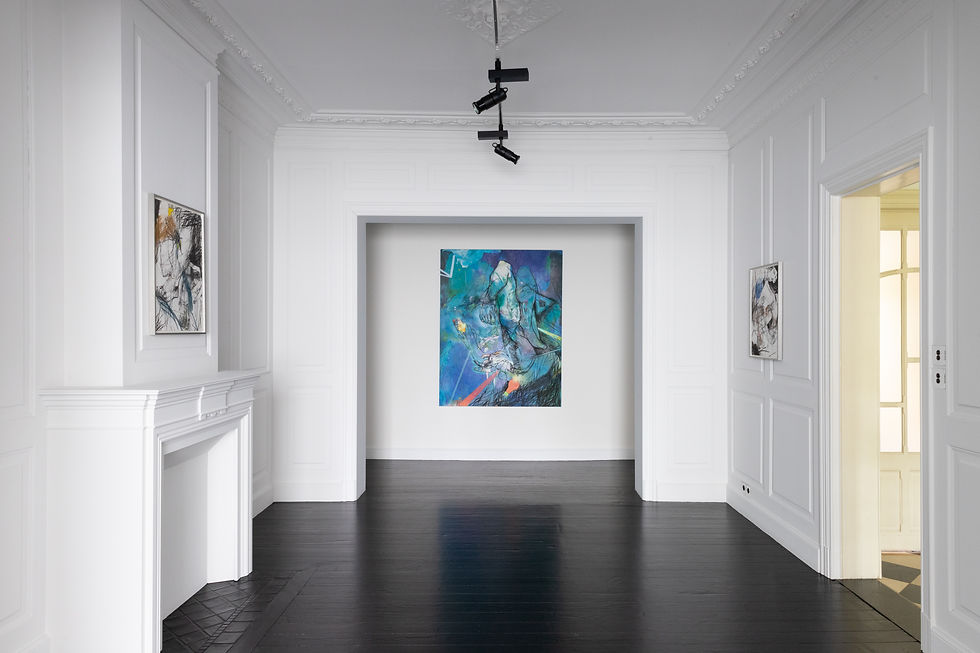The Visit - Robert Dandarov
- Uitstalling Art Gallery

- Jan 12, 2024
- 4 min read

Robert Dandarov, born 1959 in Macedonia (former Yugoslavia, is an artist whose work merges sophisticated symbols and classic iconography with the language of modern painting. His nuanced artworks pose an erudite intellectual challenge, forging a strong connection between old masters’ strategies and modern execution. Through fusion of figurative elements with colour patches, geometrization, abstraction and modern compositional shortcuts solidify Dandarov's status as a contemporary painter.
Dandarov's art is fundamentally intertwined with his personality and childhood experiences. His house, filled with reproductions that his father made frames for, moulded the classical language of art into his artistic DNA. This way, Art History became his expressive medium, by which Dandarov presents intimate, personal, and biographical experiences shrouded in dark and gloomy atmospheres, grotesque and sophisticated brutality, thereby actualising tradition of visual culture.
The artist's visual inspirations transcend specific artistic styles or periods, delving into the historical development of painting's medium. The language of old and modern art in his works blend together like magma rock, creating a nuanced fusion. Grotesques of Flemish Primitivists, Surrealism’s matter undermining, and Symbolists’ eruditeness all emerge simultaneously on the canvas.
Stepping back from the detailed canvas, what we are confronted with is a well-conceived composition that creates an arena for the main act, enabling its visual narrative to breathe and thrive. These compositions construct an intricate set of elements, at first sight causing a feeling of chaos but eventually settling down for scenes with precise meaning, revealing richness of universal symbols at play.
The first exhibition of Robert Dandarov in Poland titled The Visit takes place in MAD Gallery, a space in Poznań that presents artists collaborating with the Uitstalling Galleries (Genk, Belgium) as well as creates a platform for young Polish artists to promote their art in international context.

The presented artworks spanning 2007-2023 despite thematic diversity and formal differences, crystallise around a couple common motifs. Some of the works (especially Robert Fludd) rich in Rosicrucian symbols, delve into Dandarov's interest in alchemy and mysticism, the play of double and hidden meanings. Obsolete sciences connected to esoterism that used to explore secrets of life and universe are experiencing today's revival in mass culture. In works of Dandarov they stand as a reminder that every aspect of reality may be questioned over time - what is certain today may be no more even in the near future.

Some paintings explore the relationship between Christ and the Antichrist, prompting reflection on human nature and susceptibility to lies and moral manipulation both from internal and external factors in the quick-changing reality.
Mythology marks its presence in many works at The Visit. Playful reinterpretations of classical motifs (Study for Narcissus, Eurydice, Study for Demeter and Persephone) show the artist not only inspired by the old masters but also as a contemporary painter with an interest in the medium itself. Myths of Apollo and Daphne and Europa are recalled with use of minimal visual measures that capture their idea in the language of modern painting.

Another set of paintings takes an even more theoretical approach to the medium (Allegory of Sight, Theory of Painting or The Slit), merging figurative elements with strictly painterly matters. These works remind us of the artist’s focus on basic principles of composition and the phenomenological experience of contact with an art piece.
The painting Black Mirror (2016) embodies the artist’s interests, visionary symbolism, critique of our modern concerns and the artistic issues in the painting process. The image’s intricacy is analogous to the complex history of Dandarov’s place of origin - Republic of Macedonia. The artist represents his engagement in the topic through characters and figures important to the country's heritage (group in the left-bottom part). The painting’s rich complexity covers a range of topics, including Mythology, the Antichrist (top left, centre and right, analogy to Bosch’s The Adoration of the Magi, 1512), the complexity of Macedonia’s funding myths (Bust of Alexander III of Macedon) and personal experiences. The author here does not aim to tell a story or to provide a strict narrative. Dandarov presents us rather an image of criticising and problematising nature, that overlaps the position of the viewer with the supreme significance of art.

The painting's sophisticated narrative unfolds within a well-thought-out composition. In the upper-central part of the painting starts with a sky where our eyes are allowed to rest and get prepared before further analysis of the crowded scene’s interconnections. The painting thus acquires not only the dimension of an intellectual puzzle of meanings but also solves internal artistic problems, such as the interrelationships of forms and textures that mutually co-create a complex aesthetic experience.
Drawing on the unsettling nature of everyday life, the uncertainty of existence and the enchantment reminiscent of Bosch, Dandarov masterfully disrupts societal norms. His exploration of modern painting's language seamlessly intertwines with the fabric of contemporary visual culture. Rooted in our extensive cultural heritage, it dynamically adapts to the swift, ever-changing, and boundary-blurring landscape of today, prompting a reevaluation of the perceived certainties. The cosmic space in Dandarov's works coexists with earthly scenes, introducing a universal dimension that perhaps underscores the insignificance of mundane contexts in the grand scheme of the Universe.
The Visit serves as a revelation, a journey to the edge of the world, and a return with newfound insights. Dandarov arrives to tell us what lies at the end of the world, challenging our perceptions and engaging us to question the very essence of our existence.
Grzegorz Śliwiński, ©2024


